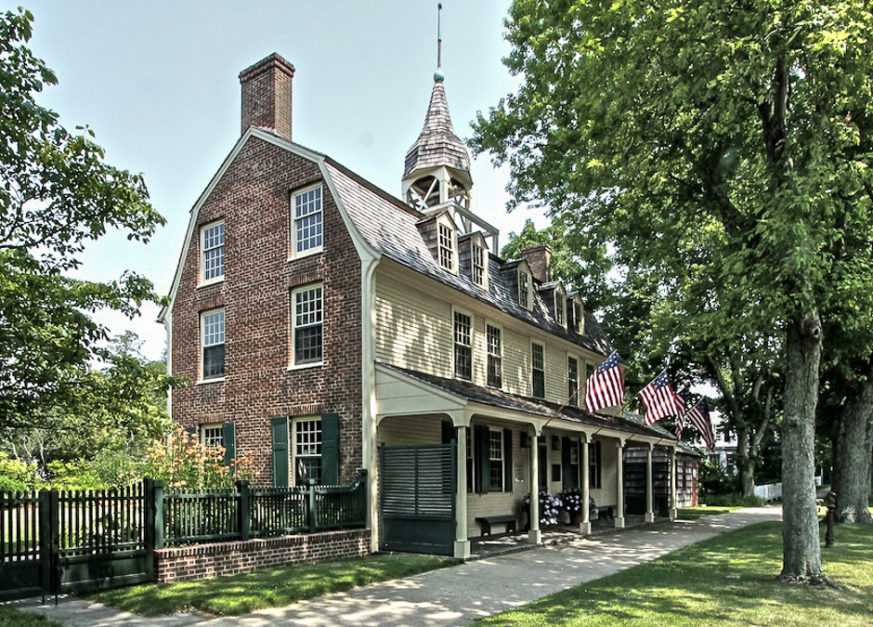|
|
March 2023
History Matters
|
|
| ~~~~~~~~~~~~~~~~~~~~~~~~~~~~~~~~~~~~ |
|
Dear Friends,
—–
Last month, I had the opportunity to go to the Winterthur Museum in Delaware and the Museum of the American Revolution in Philadelphia to research archival collections that could illuminate the past in East Hampton. The library at Winterthur houses the account books and other papers related to the Dominy family, generations of woodworkers who lived in East Hampton during the late 18th and early 19th centuries. Typically, the construction of clocks, furniture, and buildings is attributed to the Dominy who kept the account books, i.e. Nathaniel IV, Nathaniel V, or Felix. I was especially interested in finding out about who else worked in the Dominy shops. Sometimes these workers were anonymous. For example, Nathaniel IV charged “For myself and boy” to work 6 days in 1796. In other instances, he identified specific names of individuals. In the 1770s and ‘80s, the work of David, Jerome, and/or Lewis was frequently mentioned in the account books. Lewis was Nathaniel IV’s son-in-law, Lewis Conklin. By the early 19th century, shop workers included Asa, Charles, and Seth. Much more research must be conducted to learn their identities but it’s possible that Asa was Asa Miller and Seth was Seth Corwin.
————
Although woodworking occupations were largely segregated by gender in the 18th and 19thcentury, the Dominy Shops were located in a large multigenerational household. What role, if any, did Nathaniel IV’s second wife, Hannah, Nathaniel V’s wife, Temperance, and their daughters play in supporting the business? There are a few entries in Nathaniel V’s account books that show one of his daughters helped measure chairs that were being built, but overall, their handiwork has been absent from the story of the Dominys.
————
At Winterthur, I was also hoping to learn more about two individuals who are listed in a small memorandum book that was donated several years ago to East Hampton Village. Among the 18thcentury birth and death dates for Dominy family members are included “The following two servants Cuffee, born December 9th, 1742 and Genne born April 2nd 1746. She died April 7, 1815. Age 69 years, 5 days.” Unfortunately, like the apprentices in the account books, there are no surnames identified for Cuffee and Genne. In their finding aid for the Dominy collection, Winterthur identified them as enslaved. If that is the case, they were apparently emancipated by 1790 because the U.S. Census that year for Nathaniel Dominy included no enslaved people in his household.
————
As the Historical Society plans the interpretation of the new Dominy Shops Museum, we’re eager to include the stories of the apprentices and others who helped establish the Dominys’ reputation as American craftsmen. As soon as the final phases of the reconstruction and restoration of the site are complete, we’ll be announcing an opening date! We look forward to welcoming you soon.
————
Sincerely,
Stephen Long
Executive Director
|
|
| ~~~~~~~~~~~~~~~~~~~~~~~~~~~~~~~~~~~~ |
|
“Whale Off:
Sea Shanties & Early Shore Whaling in East Hampton”
——————
WINTER LECTURE SERIES 2023
Friday, March 31
————
|
|
Amagansett Life Saving Station Museum, 160 Atlantic Ave., Amagansett
———
6:30pm: Join us for traditional sea shanties performed by Nick Epstein & David Cataletto
———
7:00pm: Lecture on “A History of Early Shore Whaling in East Hampton – 4000 BC to 1917,” presented by David Cataletto
———
Free to the Public
————
Don’t miss our final Winter Lecture –
Friday, April 28 at 7pm
———
Architects, Builders, and Tools in the 19th and 20th Century
———
Speakers: Hugh King and Evan Thomas
East Hampton Library’s Baldwin Family Lecture Room
————
For more information
please email or call 631.324.6850.
|
|
| ~~~~~~~~~~~~~~~~~~~~~~~~~~~~~~~~~~~~ |
|
In collaboration with the East Hampton Historical Farm Museum
Join us Saturday, April 1pm
at Calvary Baptist Church, 60 Spinner Lane
——————
Dr. Allison McGovern discusses the history
of East Hampton’s Freetown neighborhood
————————-
|
|
| ~~~~~~~~~~~~~~~~~~~~~~~~~~~~~~~~~~~~ |
|
Tell us about yourself and your connection to East Hampton?
I grew up a free range kid in Lazy Point, Amagansett.
———
How did you first get involved with the Historical Society?
My Mother showed me photos of the attic in Clinton Academy and I really liked the old tools that are stored up there.
———
What motivates you to volunteer with the community?
I volunteer with my mother because I wanted to spend more time with her. My seasonal job
allows me the free time in the winter.
———
Do you donate your time to any other organizations?
This is my first experience volunteering with the Historical Society. I have worked with shore-line cleanups and litter patrol on our local roads. I would like to volunteer with the Coastal Research and Education Society of LI (CRESLI) and assist on their whale watch cruises.
———
Which of the Historical Society’s sites do you find most interesting? Why?
I love the array of tools stored in the Clinton Academy’s attic. I look forward to the opening of the Dominy work shop.
|
|
| ~~~~~~~~~~~~~~~~~~~~~~~~~~~~~~~~~~~~ |
|
Looking for volunteers to help with our collection!
————
|
|
Do you enjoy discovering interesting artifacts and keeping things organized? If so, please consider joining our Volunteer Team at the East Hampton Historical Society, as we continue with our collections inventory.
———
We have a few projects currently taking shape that could use extra hands and a good eye for detail.
Volunteers typically spend 2-3 hours a session, and during that time you will photograph, pack, and record data for objects. This is a great opportunity for anyone looking to develop organizational skill and data management. We can be flexible with your schedule.
———
———
Thank you!
|
|
| ~~~~~~~~~~~~~~~~~~~~~~~~~~~~~~~~~~~~ |
|
One of the joys of working with the collections is coming across objects that are not only peculiar or aesthetically pleasing but ones that also present interesting examples of how to conduct research on the collection itself. It is all too common to feel a sense of monotony when dealing with hundreds of objects day in and day out, especially ones that are similar in nature. How many porcelain dishes, for example, can one really get excited about?
————
Sometimes, though, a certain object will stand out from the rest, causing one’s sense of time to slow down while closely observing and handling the object, asking questions about its many origin stories. This fabulous and brightly colored fish-shaped porcelain dish (77.4.253) presented such an encounter the other day. Its uniquely elongated shape and jutted fins made it immediately recognizable as an anthropomorphic object distinct from the many circular or oval dishes in the collection. Looking more closely, two distinct fish appear in the colorful details, or perhaps it is a single fish casting its own reflection along the water. The rich detail and golden highlights only add to the wonderful optical play, catching bits of light like a wet, scaly fish would.
————
|
|
While I recognized how the numbering sequence on the bottom placed the object within the Wheelock Collection (like last month’s bedwarmer), I was surprised to find a different numbering sequence for the many similar porcelain pieces nearby. While they all seemed to belong together visually by classification, the other objects presented more helpful information.
————
Many of these other objects, like this blue and white vase (97.21.28), were donated by Charles William Sampson, Jr. in the 1990s, and together are classified as Chinese Export and Imari porcelain. Historically, objects such as these were made for foreign export and trade, circulating in the millions from East Asia to Europe and North America from the fifteenth century through the late-nineteenth century, effectively influencing not only collecting practices but also aesthetic tastes in the West.
|
|
|
————
European porcelain makers drew on these imported goods over the centuries as they developed their own styles. Throughout the nineteenth century Western artists and collectors would purchase and display such goods in their homes, as was the case for Thomas and Mary Nimmo Moran. Curiously, going through the inventory their daughter Ruth made of goods in their East Hampton home before her death in 1949, we find numerous examples of early chinaware. Many of these were produced in Germy and Italy, which the Morans likely brought back with them from their travels abroad in Western Europe during the late 1860s. By displaying these objects at the Moran Studio, we can discuss both Thomas Moran’s artistic pursuits and his travels. But we can also tell part of the larger story about cultural exchange throughout the modern world, as well as the collecting habits of affluent and tasteful families in recent years of East Hampton, like the Wheelocks and the Sampsons.
|
|
| ~~~~~~~~~~~~~~~~~~~~~~~~~~~~~~~~~~~~ |
|
A Shop Full of Unique Gifts Online!
———
Check out the great items online!
———
You can shop online and have your order shipped directly to you or picked up at Clinton Academy.
———
Use code FLASH for 50% off your order.
|
|
| ~~~~~~~~~~~~~~~~~~~~~~~~~~~~~~~~~~~~ |
|

Clinton Academy, 1784
————————— |
|
East Hampton Historical Society
|
|
|
|
|
|
|
|

